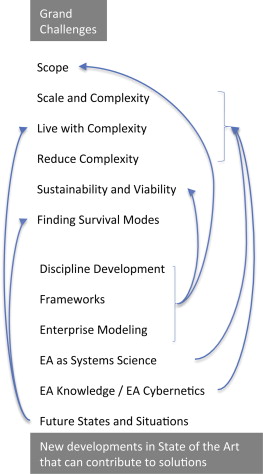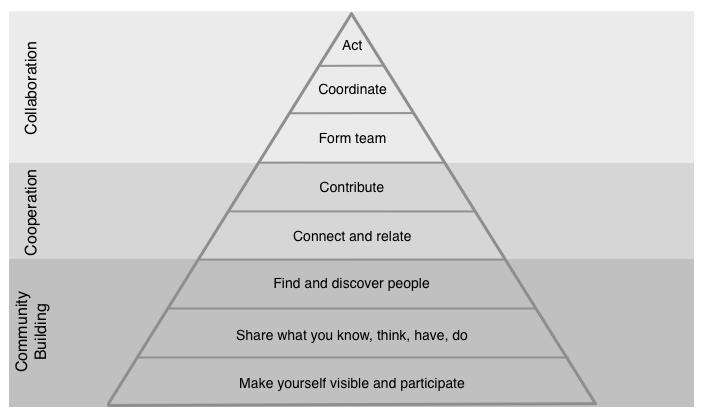Enterprise Architecture is facing several challenges as a discipline and a practice. In this blog post, John Gøtze outlines four central challenges, and discusses what should be done. He suggests that enterprise architecture management must focus on enterprise collaboration.
The Challenges
The discipline Enterprise Architecture (EA) is at a crossroads, facing four challenges:
- The first challenge is to overcome the narrowness of scope of present practice in EA, and re-gain the coverage of the entire business on all levels of management, and a holistic and systemic coverage of the enterprise as an economic entity in its social and ecological environment.
- The second challenge is how to face the problems caused by complexity that limit the controllability and manageability of the enterprise as a system.
- The third challenge is connected with the complexity problem, and describes fundamental issues of sustainability and viability.
- Following from the third, the fourth challenge is to identify modes of survival for systems, and dynamic system architectures that evolve and are resilient to changes of the environment in which they live.
A recent (in-press) peer-reviewed article, Enterprise Engineering and Management at the Crossroads – the result of a collaborative effort between eleven authors from four continents – discusses these four challenges and the state of the art of the discipline of Enterprise Architecture, with emphasis on the challenges and future development opportunities of the underlying information system, and its IT implementation, the Enterprise Information System (EIS).
Responses
The article provides pointers to possible radical changes to models, methodologies, theories and tools in EIS design and implementation, with the potential to solve these grand challenges:

Towards Solutions
The article argues that EA needs to embrace full or broad views of the enterprise as per the original vision of the discipline’s mission that originated in manufacturing (e.g. computer integrated manufacturing systems), and the parallel developments in information systems and software development. This division between information systems, system science, and manufacturing & industrial engineering needs to be resolved as it is still felt today and hampers the discipline of EA as a whole. Any credible development of the discipline must equally cover and explain deliberate change and evolutionary change in a system of socio-technical systems, the production & service to the customer, and the management & control of the enterprise, the technical resources (logistics, manufacturing machinery, communication systems, computer systems), human resources, financial resources, and assets of all other kind (knowledge & information assets, buildings and grounds, and various intangibles).
As EA is moving up the hierarchy from technical to management levels, the language and skill set of its practitioners has to change to better reflect the specific needs and language of the management community. This needs to be reflective in terms of not only language, but also culture. The focus must be on views of the organisation that management science is interested in (People, Capability, Place, Role, Relationships and Trust, Risk, Finance, Brand Strategy, Knowledge Management) rather than detailed, possibly local technical views of the organisation.
A central concern in EA is the development of the information system that implements a coherent, aware behaviour of the enterprise on any scale. It is acceptable (even desirable) that the implementation of these properties should not have a single locus, so that the system should display these properties without a single subsystem or system component being responsible for them. If awareness and coherency are emergent properties of the enterprise, it is likely that the enterprise (and its information system) would be more resilient in terms of being able to maintain these systemic properties.
A New Paradigm for EA
The article suggests a new paradigm for EA:
It is clear that the future is not in EA reinventing the complete gamut of management models, but it is in providing a unifying platform through which the multiple models used in the various life cycle phases and in the various stages of the enterprise’s life history can be combined. The combination needs a new paradigm though, as current EA methodologies struggle with the reality of complex relationships among models present at different abstraction levels. In essence, guided evolution of the enterprise requires that enterprise modelling not be seen as a top-down or bottom up process, but as a powerful problem finding and problem solving tool that supports transformational activities both on the strategic and operational levels.
In my article from 2013, The Changing Role of the Enterprise Architect, I argue that in facing ‘wicked problems’, enterprise architects must focus more on problem-finding than problem-solving; true craftsmen look at situations in a problem-finding manner, rather than blindly applying the same method and tool every time to what may be a new and interesting challenge.
Enterprise architecture practice must be collaborative, and enterprise architects should be cooperative in character, able to engage in many kinds of communication and collaboration. I argue that enterprise architects must have both:
- dialectic skills and competencies in resolving conflicts, creating consensus, synthesis and common understanding, detecting what might establish that common ground, and the skill of seeking the intent rather than just reading the face value of the words, and
- dialogic skills including listening well, behaving tactfully, finding points of agreement, managing disagreement, and avoiding frustration in a difficult discussion.
Jason Uppal picks up on this in his lecture at a recent EA conference.
The dialectic/dialogic distinction is of course a classic discourse in educational research (see for example Rupert Wegerif, Richard Paul, and Andrew Ravenscroft) and generally throughout the critical social sciences (“Bakhtinian dialogic and Vygotsky’s dialectic”) ever since Hegel.
In Together: The Rituals, Pleasures, and Politics of Cooperation sociologist Richard Sennett states that the distinction between dialogic and dialectic is fundamental to understanding human communication. Sennett says that dialectic deals with the explicit meaning of statements, and tends to lead to closure and resolution. Whereas dialogic processes, especially those involved with regular spoken conversation, involve a type of listening that attends to the implicit intentions behind the speaker’s actual words. Unlike a dialectic process, dialogics often do not lead to closure and remain unresolved. Compared to dialectics, a dialogic exchange can be less competitive, and more suitable for facilitating cooperation. Sennett explains further in a lecture at Harvard: The Architecture of Cooperation.
The Importance of Enterprise Collaboration
Cooperation and collaboration are closely related concepts, and often thought of as synonymous. In fact, they are quite different.
Oscar Berg‘s Collaboration Pyramid may explain the difference:

Berg distinguishes between the three layers in this way:
- The community is the enterprise seen as a group of individuals that share the same purpose, vision and values. It is about shared attitudes and behaviors within the enterprise, or the culture if you like. It is also about the individual’s ability to be seen, participate and be recognized, all of which are fundamental for developing a sense of belonging, identity, and self-confidence.
- Cooperation is about people enabling each other to do something, for example by providing a person with information or other resources that make the person more able to perform a task. Cooperation can be seen as the opposite of selfishness and competition. People help each other out for some mutual benefit.
- Collaboration is about a team of people that work closely together to achieve a certain goal. It can be a permanent team, like a production unit at an assembly line, or temporary team, like a project team. The team would most likely have a formally appointed leader, someone who is responsible for the planning, coordination, follow-up, and communication within the team as well as the world outside the team.
Enterprise collaboration is a term that covers all these three all-important concepts of the “social” enterprise. The term is often mistakenly used to cover social networking tools and intranet, but should be seen as a wider concept and a more comprehensive platform for the enterprise, wherefrom strategic alignment and viable process and information flows are tangible outcomes.
In our Collaboration whitepaper, we explain further how QualiWare is enabling our customers to work with collaboration in their enterprise architecture work.